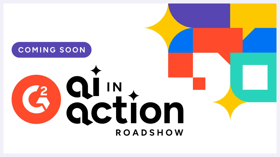April 29, 2025
 by Tanushree Verma / April 29, 2025
by Tanushree Verma / April 29, 2025

AI without orchestration is just noise.
What if your AI agents actually talked to each other? In today's world, where fragmented solutions create disjointed customer experiences, one company is challenging the status quo with a radically different approach.
In my recent conversation with Claire Ebben, Director of product marketing at Qualified, we delved into the transformative world of AI-driven marketing strategies. As companies increasingly integrate AI into their customer journeys, Claire offers valuable insights on how orchestrated AI agents are reshaping the B2B marketing landscape.
With the AI in Action Roadshow just around the corner, Claire also shared some inside scoop about her upcoming panel discussion and what attendees can expect to gain from this conversation on unified AI implementation.
This interview is part of G2’s Q&A series. For more content like this, subscribe to G2 Tea, a newsletter with SaaS-y news and entertainment.
To watch the full interview, check out the video below:
What inspired Qualified to develop an orchestrated approach to AI agents rather than deploying them in isolation?
I think we recognized early on that AI agents can't drive meaningful outcomes if they operate in silos. Buyers expect a cohesive, personalized journey, not fragmented interactions with disconnected agents.
Our product unifies AI into a single super agent that works across the entire marketing funnel. This gives the agent complete context, adapting it to intent signals and actions in real time and creating a seamless customer experience. This shift was inspired by the evolving complexity of B2B buying journeys, where timing, personalization, and continuity have become critical to conversion in today's market.
What makes our approach particularly effective is the way it bridges traditional gaps between marketing touchpoints. Rather than having separate systems handle different stages of customer engagement, we've created a seamless intelligence layer that maintains relationship continuity. This not only improves the customer experience but also provides deeper analytical insights across the entire journey.
How do you ensure your AI agents maintain an authentic brand voice while still achieving automation efficiency?
Yeah, many of our customers are thinking about this because everyone is exploring AI agents across different business lines. Maintaining a unified voice is definitely a hot topic right now.
I believe it starts with establishing clear brand guidelines, tone, and messaging pillars during your AI strategy development. These foundational elements should then be integrated into your AI model training and prompt design process.
It's also crucial to view every AI agent not just as a tool, but as a true representative of your brand. At Qualified and with our AI sales development representative, AISDR, Piper, we implement human-in-the-loop quality assessment, allowing her to leverage conversational templates that are carefully tailored to each persona and funnel stage.
As the owner, you can continuously monitor these interactions and provide feedback. The goal isn't to replace the human nuance in these conversations, but rather to replicate it in a scalable way that remains authentic to your brand.
What framework do you use to determine which touchpoints in the funnel should be AI-driven versus human-driven, and how can you maintain that balance?
I think looking at three key dimensions — volume, value, and variance — provides a clear framework. What I mean is that high-volume, low-variance interactions like answering questions or qualifying leads are ideal for AI. The more high-value or high-variance moments, such as late-stage deal cycles, are best handled by humans.
When we overlay buyer intent and deal stage, AI should help guide and accelerate the process, but humans should lead where relationships and trust are at stake. Agents are there to scale high-volume interactions, freeing humans to focus on what they do best: selling. And the lower-tier activities are great for agents to accomplish.
To maintain the right balance between AI agents and human involvement, treat your AI agent like an onboarded employee. Build an internal coalition of stakeholders who have a voice in how this agent will represent your brand, including team members from sales, marketing, and, potentially, product.
Develop a framework by establishing the agent's roles and responsibilities and how they should present themselves as a brand representative. And then, once you've developed that framework, it's really about onboarding that agent and using that human-in-the-loop to evaluate how they're answering questions, defining clear goals, and determining appropriate handoff points for human intervention.
But it all develops by having that cross-functional group of customer-facing experts who can bring their valuable perspective to your agent deployment.

Join industry leaders at G2's free AI in Action Roadshow for actionable insights and proven strategies to reimagine your funnel. Register now
When orchestrating multiple AI agents across marketing and sales funnels, what technical challenges should companies watch out for? And how can they make sure data flows smoothly between agents to keep the customer experience feeling seamless?
I think the biggest challenge for agents is really the fragmentation of data sources. AI is only as good as the data you feed it. If you want your agent to interact with your prospects, website visitors, and leads in a cohesive, intelligent way, it will need awareness of all the context that’s happening around their lead, their account, etc.
That's why at Qualified, we built our agent on top of our platform, which has this native data layer that integrates with Salesforce and other go-to-market (GTM) systems like marketing automation, account-based marketing (ABM) platforms, and sales engagement platforms. It also incorporates real-time website activity, unifying all this information so the agent understands who the lead is, what segment they belong to, why they're important to your business, and what they're actually interested in.
This comprehensive data integration allows the agent to have truly intelligent conversations and touchpoints that wouldn't be possible otherwise. And so, I think you want to look for agents like this that are built on a really robust data platform because, without that data, the interactions that the agent is going to have are not going to be as powerful.
What common misconceptions do you encounter about AI-driven conversion strategies that you'd like to debunk?
I think one big myth is that AI isn't good enough yet to handle certain aspects of roles like human sales development representatives (SDR).
"When properly orchestrated, AI serves as a strategic layer that can augment your pipeline engine. It's not about automation, it's about acceleration, personalization, and precision."
Claire Ebben
Director, Product Marketing at Qualified
Another misconception is that AI will completely replace human teams. I don't think it necessarily does that, but it empowers those humans to actually focus on what they do best.
Currently, we assign human SDRs many tasks that AI can accomplish. Assigning these tasks to AI allows us to elevate the professionals to higher-value activities like outbound prospecting and becoming account executives who close business. That's where today's needs lie, and we're increasingly seeing our customers adopt this approach as AI assumes more of these core responsibilities.
Looking ahead, how should companies balance building internal AI orchestration capabilities versus partnering with platforms like Qualified that already have integrated solutions? What considerations should guide this build versus buy decision?
I think the build versus buy decision should really be driven by time to value and scalability. Building from scratch is a resource-intensive process that's prone to gaps in security, compliance, and customer experience. It will take exponentially more time than adopting a purpose-built solution. And so, platforms like Qualified offer speed, proven architecture, ongoing innovation, and best practices that we can bring to the table to build a bespoke agent for our customers.
That said, if you have an AI-mature team and a very specific need, hybrid approaches can work well, too. Your team might develop proprietary components while using existing solutions for the foundation. This gives you both customization and reliability. So, ultimately, the question is: do you want to spend time building the plumbing, or do you want to invest that precious time in accelerating your pipeline and driving results?
Do you have any tips for budding marketers out there? What should they be looking out for in the coming years when it comes to AI agents, and how should they go about it?
As a marketer, I think it's incredibly challenging to stay on top of all the innovation happening in this space. My biggest tip has been to consistently look for ways to become AI experts ourselves and integrate AI more extensively within our own roles.
I've started applying ChatGPT to my everyday tasks, but I'm also exploring other AI tools that can help with content creation and pipeline management, while strategizing with my team on effective implementations.
"I believe any marketer who isn't focused on AI right now risks getting left behind."
Claire Ebben
Director, Product Marketing at Qualified
Starting with your own role and identifying where AI can accelerate your core responsibilities is an excellent entry point. The most important advice I can offer is simple: you have to start now.
You are on the panel discussion for the AI in Action roadshow. Can you share some inside scoop with us on how you are approaching it, what to expect, and what we should be looking out for?
I am very excited about this session! We'll specifically focus on AI agents in the AISDR space within marketing and pipeline generation.
What makes this particularly interesting is the partnership dynamic between us and 6Sense. We will be discussing how our companies work together. 6Sense is our customer and we're theirs, and many marketers are currently using both platforms in tandem and looking to us for guidance.
A key focus will be addressing questions about agent deployment and integration, like:
We'll also share practical use cases that attendees can apply to their own situations, highlighting where our customers have seen the most success. So it's going to be super interesting, and we're very excited to dive deep into some of these use cases.
If you enjoyed this insightful conversation, subscribe to G2 Tea for the latest tech and marketing thought leadership.
Follow Claire Ebben on LinkedIn to learn about AI agents and how you can leverage them.
Edited by Supanna Das
Tanushree is an Editorial Content Specialist at G2, bringing over 3 years of experience in content writing and marketing to the team. Outside of work, she finds joy in reading fiction and indulging in a good rom-com or horror movie (only with friends). She is an enthusiastic dancer, a lover of cat reels, and likes to paint. A dedicated Swiftie, Tanushree also has a deep love for Hindi music.
Will the art of selling become another casualty of automation?
 by Tanushree Verma
by Tanushree Verma
What if mastering artificial intelligence didn't require becoming a technical expert?
 by Tanushree Verma
by Tanushree Verma
AI is no longer just helping B2B buyers; it’s making decisions for them.
 by Alexandra Vazquez
by Alexandra Vazquez
Will the art of selling become another casualty of automation?
 by Tanushree Verma
by Tanushree Verma
What if mastering artificial intelligence didn't require becoming a technical expert?
 by Tanushree Verma
by Tanushree Verma


